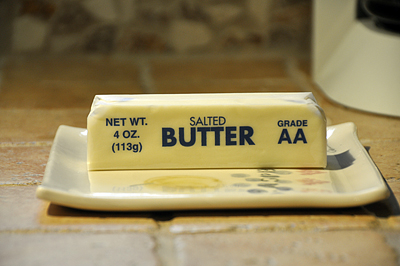
If you have read many of these experiments, you know that I like experiments that deal with food. Part of this is because I really like to eat. I also like to cook, finding it very relaxing. I also seem to get lots of good feedback from the food related experiments, telling me that many of you like to eat too. This experiment comes from the wonderful dinner we had tonight. Our good friends Bob and James came by today and we went out to eat. I ordered a bucket of steamed oysters (I LOVE oysters!) and I was enjoying dipping them in the various combinations of horseradish, cocktail sauce, and butter. I especially like the clarified butter you get with seafood and that got me thinking about the chemistry butter. To investigate this, you will need:
- at least a couple of tablespoons of butter (not margarine)
- a skillet or sauce pan
Lets start with the history of butter. Butter has been used for a long time. There are references to butter as far back as 2000 BC, although at that time it was used mostly as a medicinal ointment and as oil for lamps. Today, most butter is made from cow's milk, but it has also been made from the milk of goats, sheep, horses and other mammals. There are different ways to make butter, but basically you let whole milk separate so that the cream comes to the top. This cream is then churned or shaken, causing the bits of butterfat in the milk to stick together, forming lumps of butter.
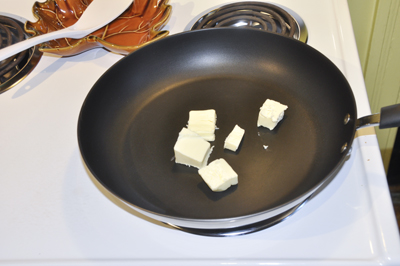
If you want to try that yourself, check out the Making Butter video.
Butter is actually several different substances mixed together. We are going to separate these substances. Cut a couple of tablespoons of butter into small pieces and put them in the pan. Turn the heat on low and watch as the butter melts. You will quickly notice that there are different parts to the butter.
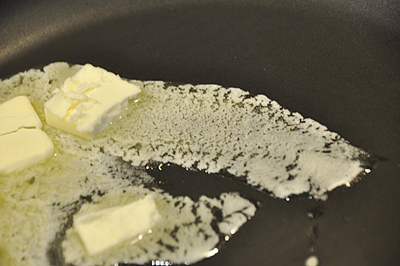
You will see a clear, yellow liquid with lots of white bits floating in it. Continue heating and you will notice that the butter begins to sizzle. At this point, remove it from the heat.
There will be a white foam floating on top of the butter and bits of white, solid stuff will settle to the bottom. In the middle is the yellow liquid. Use a spoon to remove the white foam. You can then carefully pour the yellow liquid into a small container.
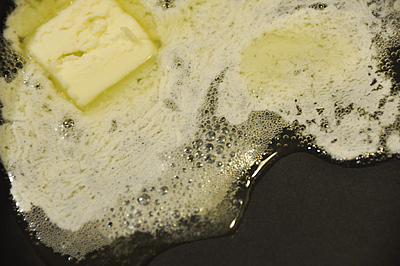
Another way to make clarified butter is to place the butter in a small container and place it in a very warm place. The butter will melt and separate into layers. You can then spoon off the foam from the top and carefully pour off the clear, yellow liquid. You don't get the sizzle, so you miss seeing evidence of one of the substances present in the butter, but you also don't need to use the stove.
OK, now what is all this stuff? Well, butter is made up of fat, protein, and water. They form an emulsion, which means that you have a mixture of substances that usually don't mix (oil and water).
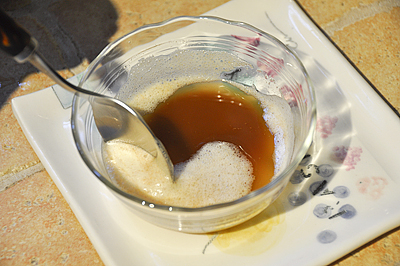
giving the butter fat a wonderful flavor.
Often, butter has salt and air added to it as well. As you melted the butter, the emulsion separates. The yellow liquid is the fat. The solid, white stuff is the milk proteins. The sizzle of the heated butter was the water boiling away. The foam which forms on top of the butter is mostly due to air that is trapped in the butter during processing.
You can use either salted or unsalted butter in this experiment. If you use salted butter, you need to watch it more closely to keep it from scorching. The salt raises the boiling point of the water in the butter, which means less time between when the water starts to boil and when the proteins begin to burn.
Why do people make clarified butter, which is also known as drawn butter? There are several reasons. First, by removing the solid milk proteins, you can use the butter to cook at much higher temperatures. Regular butter begins to smoke when you heat it to about 248 degrees Fahrenheit. At that point, the proteins begin to scorch, producing a bitter flavor. By removing these proteins, you can heat the clarified butter up to 375 degrees before it starts to smoke. This makes it very useful for cooking food which you want to cook at a high temperature.
The second reason for removing the milk proteins is that it helps keep the butter from spoiling. These proteins are largely responsible for the butter going rancid as it gets old, and properly clarified butter can be kept for a long time without going bad. The better job you do of removing these proteins, the longer the butter will keep.
Now, I can hear some of you asking why isn't all butter clarified. Removing the milk proteins also removes a lot of the flavor. Once it cools, compare the taste of the clarified butter with regular butter and you should taste a big difference. While it tastes marvelous with oysters, lobster and other seafood, it would not have the butter flavor that we like in other foods. Don't waste that clarified butter! If you don't have any oysters or lobster laying around, it is also very good on popcorn. Or heat it again with some garlic, and use it for dipping crispy strips of toasted bread. YUM!
























